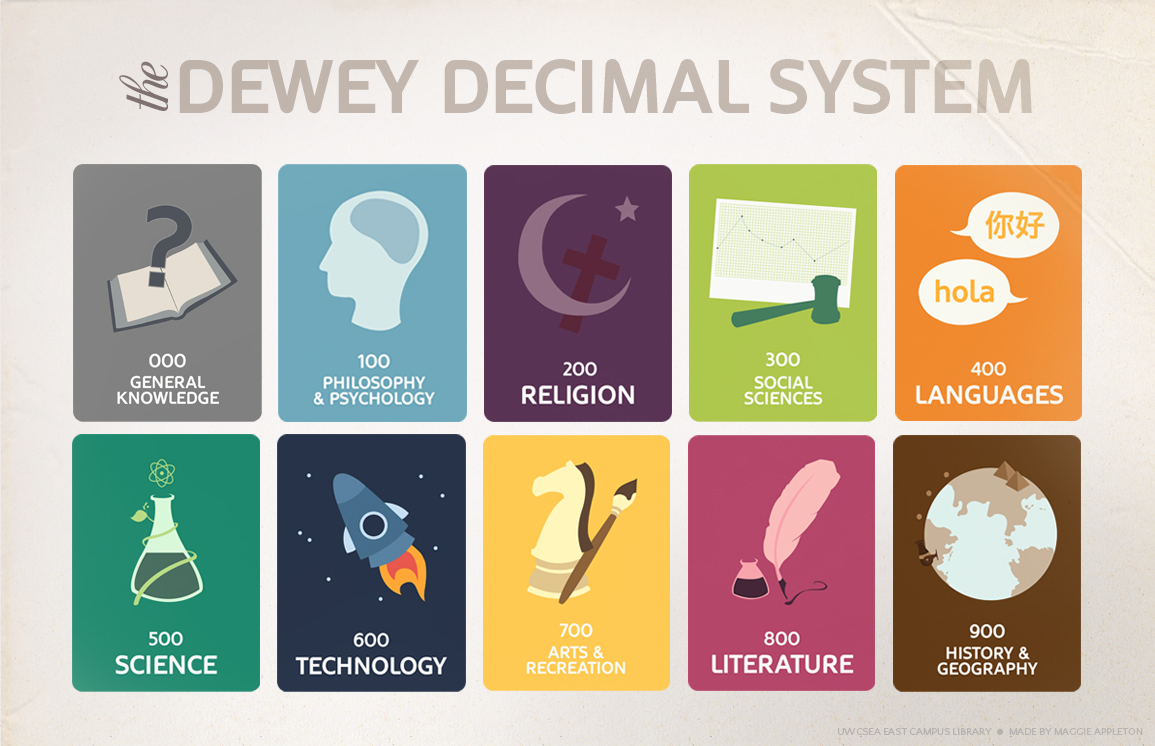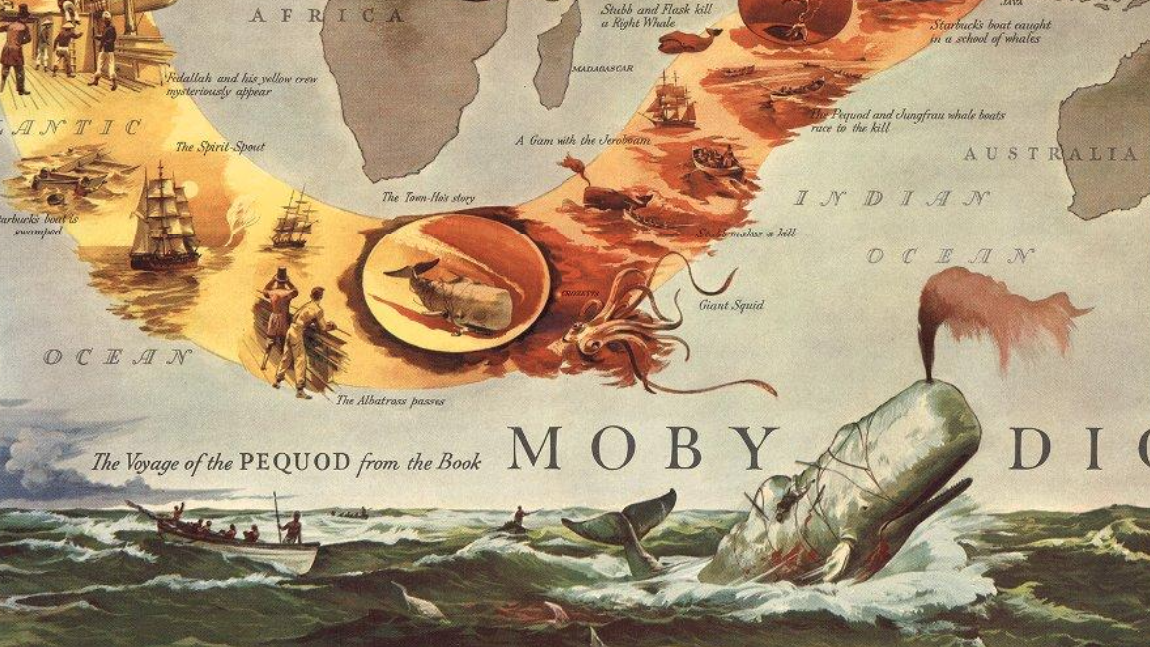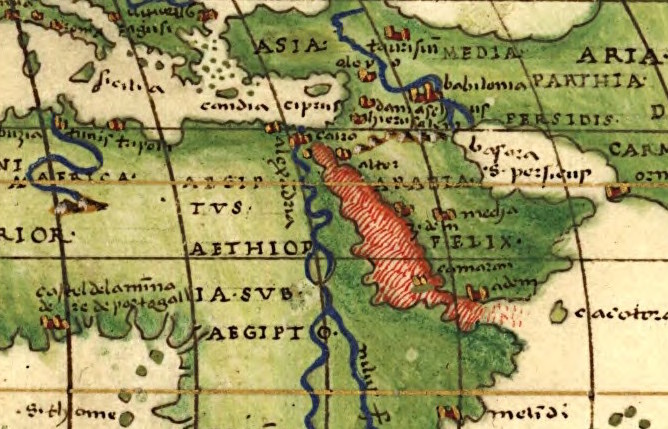Dewey Decimal: The sorting system that revolutionized libraries

- Before the Dewey Decimal Classification, there was no standardized system for sorting library books.
- Thanks to the DDC system, each topic has a “relative location” and can be refined indefinitely.
- Still, the system has its flaws, and so did its inventor. But if anything will kill it, it’s the internet.
Peculiar sets of numbers populate this 1936 map of the U.S. Each state is labeled with a number that is about the same order of magnitude as the others: Nebraska is 978.2, West Virginia is 975.4, and so on. Similar numbers show up next to the local product or industry shown for each state, such as cars (629.2) in Michigan (977.4), mining (622.2) in Colorado (978.8), and cattle (636.2) in Texas (976.4). The digits also apply internationally: to Mexico (972), Canada (971), and the Panama Canal Zone (986).
Know thy shelf
Bookish types will have guessed what’s going on here even without looking at the title of the map: They are Dewey numbers, indicating where on the shelves of your local library you can find the topics they denote.

The legend in the map’s lower left corner gives an example of how versatile this system is: Books on the history of a state will be found on the shelves under the Classification Number shown on the Map. The Shelf Number for Books of Travel, etc., will be found by placing Figure 1 after the Initial 9. Thus, the History number for Illinois 977.3 becomes 917.73 for Travel, Topography, etc.
If you detect a whiff of missionary zeal in the above description, that’s no accident. If it were up to librarians, history would be divided into two eras: Before Dewey and After Dewey.
Before the Dewey Decimal Classification system (or DDC), there wasn’t really a universal way of organizing a library. You could rank the books alphabetically (by author or title) or group them thematically. Either option creates order of some kind, but chaos of another.
That’s why some pre-Dewey libraries were happy to use more haphazard sorting methods: arranging books by size, by their date of acquisition, or even purely on the whim of the librarian. The key to finding the book you wanted in these near-randomly organized book depositories was a catalog that listed all books and their locations, assuming it was up to date.
1876: Year Zero
All that changed from 1876, Year Zero for the DDC system. That’s when Melvil Dewey, who had developed the system for Amherst College library, published a pamphlet proposing its universal application. Dewey’s system uses decimal numbers to divide books into 10 main categories, which can be progressively refined.
For example: 0 is “information,” 2 is “religion,” and 6 is “technology.” Delving deeper into the last category, 63 is “agriculture and related technologies,” and 635 is “domestic gardening,” Each three-digit code thus refers to a specific topic, which can be subdivided further: In the latter case, it subdivides into “flowers and ornamental plants” (635.9) and “diseases and pests of ornamental plants” (635.93), among other subcategories. Dewey revolutionized library sciences by introducing two key concepts: relative location and relative index.
Relative location refers to the topical hierarchy established by the decimal numbering, meaning that related subjects are grouped together. For example, books on birds (598) will be near books on reptiles (597.9) and amphibians (597.8).

The relative index is a giant subject dictionary for the system, with an alphabetical listing of terms and phrases and their corresponding DDC numbers. It’s “relative” because it gives you the subject area within the DDC system for the topic you’re researching rather than a physical location. And that relative position will always remain the same, no matter the library that uses Dewey.
It is this double use that makes the DDC notational system so ingenious: It’s a tool for both physical access (as a system of shelf arrangement) and intellectual access (as a classification system). Because it is based on numbers, it can be translated into other languages. As a result, the Dewey Decimal system is used in more than 200,000 libraries across most countries — a virtual global monopoly.
As a universal, adaptable, and user-friendly classification method, Dewey provides the “flexible granularity” that has helped standardize libraries even as they expand, to the benefit of both librarians and library users. In digital parlance, DDC is the http:// of the library world.
There are, however, a few clouds hanging over Dewey. The first one is its inventor himself, who was brilliant yet flawed — enough so that he got canceled in his own day.
Formerly known as “Dui”
Born in 1851 in upstate New York, Melville Dewey was an ardent educator and advocate of several causes, including metrication, library standardization, and spelling reform. For a while, he wrote his own name as Melvil Dui, but he later reverted to the more familiar spelling of his surname.
Dewey was a prolific founder. In 1876, the year he published the first version of the DDC system, he also set up the Library Bureau (1876). The Bureau sold furniture and specialized supplies to libraries around the world, including the library index cards he helped standardize. It also had a unit devoted to “library loss-management,” which managed to recover 3,000 books in its first year alone.
In that same year, Dewey also founded the Library Journal, of which he became the editor; co-founded the American Library Association (ALA), which he would preside in 1891 and 1893; and established the American Metric Bureau, of course editing its official publication, the Metric Bulletin.

Dewey wasn’t done: He went on to found the School of Library Economics (1884), the New York Library Club (1885), the Spelling Reform Association (1886), and the American Library Institute (1905).
Meanwhile, he racked up prestigious appointments, first as chief librarian of Columbia University, then as executive officer of the University of the State of New York, and as New York’s state librarian, a position in which he pioneered traveling libraries and picture collections.
As the founder of the Lace Placid Club (1895), Dewey was instrumental in developing the small New York town into an international destination for winter sports, and eventually the host location for the Winter Olympics (in 1932 and again in 1980).
But Lake Placid also brought out a darker side of Dewey’s character. He wrote the club policy that excluded Jews and other minorities from membership. In 1904, the New York State Board of Regents received a petition to remove Dewey as state librarian because of the Club’s racist policies. Dewey was merely rebuked, but he resigned himself.
Racism and sexual harassment
Another of Dewey’s more prominent flaws was his “persistent inability to control himself around women,” as one biographer put it. He hugged, touched, and kissed his female employees and other women he met professionally, whether they wanted him to or not.
Having made unwelcome advances to no less than four female librarians on a single ALA trip to Alaska in 1905, he was forced to end his participation in the Association’s activities. But the stream of allegations continued. As late as 1929, two years before his death, he settled a lawsuit out of court brought by a woman whom he had kissed and caressed in public against her will. Dewey himself only admitted to “frankly showing and speaking of his liking for women.”
The wheels of justice move slowly. In 1951, 20 years after his death, Dewey was inducted into the ALA’s Hall of Fame. Only in 2019, citing Dewey’s history of racism and sexual harassment, did the ALA remove his name from its top honor. In 2020, the Melvil Dewey Medal was renamed the ALA Medal of Excellence.

Dewey’s questionable reputational afterlife is one thing. An arguably more serious problem is the limitations of the DDC system itself. The system can be complex and cumbersome, having difficulties integrating entirely new fields of knowledge, like anything relating to the digital world.
The DDC system is maintained and periodically updated by OCLC, a nonprofit cooperative that also runs WebDewey, an online version of the system. Yet past or current biases are evidence that the system was conceived within a framework of specific values.
The DDC in the modern world
For example, older versions of the DDC were prejudicial against women, by having a separate category labeled “women’s work” (under general jobs), or by placing women-related topics close to categories on etiquette (suggesting that women were especially beholden to behave properly).
Topics related to homosexuality were first introduced in 1932, under 132 (“mental derangement”) and 159.9 (“abnormal psychology”). As late as 1989, they were classed under 263.49 (“social problems”). Since 1996, the preferred location is 306.7 (“sexual relations”). And in category 200, religion, the rankings skew heavily toward Christianity: subcategories 210 to 280 relate mainly to the predominant Western religion, while all the other faiths are squeezed into subcategory 290, “other religions.”
But perhaps the biggest threat to Dewey is the sorting system that has superseded all others: the internet, where anything, if properly labeled, is easily findable. In the future, when every single physical book has its own IP address, libraries might not need Dewey anymore, or any other sorting system. Readers of physical books — if there are any left — may be able to simply geolocate the copy they need. And librarians — if any remain — can go back to arranging their collections by whimsy.
Strange Maps #1237
Got a strange map? Let me know at strangemaps@gmail.com.
Follow Strange Maps on X and Facebook.





